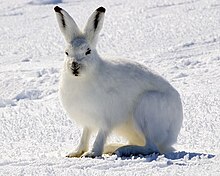| Arctic hare | |
|---|---|

| |
| Arctic hare in Nunavut, Canada | |
| Scientific classification | |
| Domain: | Eukaryota |
| Kingdom: | Animalia |
| Phylum: | Chordata |
| Class: | Mammalia |
| Order: | Lagomorpha |
| Family: | Leporidae |
| Genus: | Lepus |
| Species: | L. arcticus
|
| Binomial name | |
| Lepus arcticus Ross, 1819
| |
| Subspecies | |
|
4, see text | |

| |
| Arctic hare range | |
The Arctic hare[2] (Lepus arcticus) is a species of hare highly adapted to living in the Arctic tundra and other icy biomes. The Arctic hare survives with shortened ears and limbs, a small nose, fat that makes up close to 20% of its body, and a thick coat of fur. It usually digs holes in the ground or under the snow to keep warm and to sleep. Arctic hares look like rabbits but have shorter ears, are taller when standing, and, unlike rabbits, can thrive in extreme cold. They can travel together with many other hares, sometimes huddling with dozens or more, but are usually found alone, sometimes taking more than one partner. The Arctic hare can run up to 60 kilometres per hour (40 mph).[3]
- ^ Smith, A.T.; Johnston, C.H. (2019). "Lepus arcticus". IUCN Red List of Threatened Species. 2019: e.T41274A45185887. doi:10.2305/IUCN.UK.2019-1.RLTS.T41274A45185887.en.
- ^ Hoffman, R.S.; Smith, A.T. (2005). "Order Lagomorpha". In Wilson, D.E.; Reeder, D.M (eds.). Mammal Species of the World: A Taxonomic and Geographic Reference (3rd ed.). Johns Hopkins University Press. pp. 195–196. ISBN 978-0-8018-8221-0. OCLC 62265494.
- ^ "Arctic Hare". National Geographic. Archived from the original on June 13, 2007. Retrieved September 4, 2009.
